|
ARBOR Technology G60
Tough and impressively rugged 5-inch Android-based Mobile Inspection Assistant with integrated thermal imaging, PTT, and extensive data collection features
By Conrad H. Blickenstorfer; photography by Carol Cotton
Share on:




AMobile is a Taiwan-based joint venture of embedded systems and networking manufacturer ARBOR Technology, semiconductor company MediaTek, and Konka group which specializes in industrial mobile computers and solutions for industries such as inspection, firefighting, transportation, logistics, warehouse management. The G60 was launched late 2017 as what the company called "the world's first 3-in-1 mobile inspection assistant," the 3-in-1 referring to the fusing of smartphone, push-to-talk radio, and thermal imager. RuggedPCReview has had a chance for extended hands-on with the AMobile G60, and this report presents our review and observations.
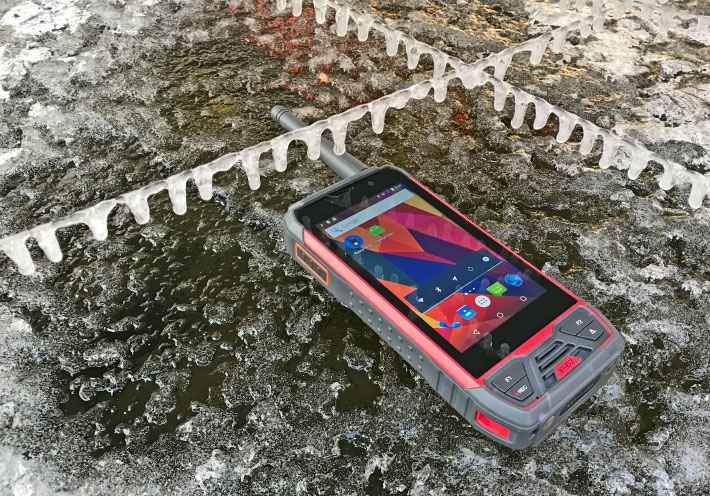
Integrating thermal imaging, and more
To get right to the point, what, exactly, is "thermal imaging"? It's being able to capture electromagnetic radiation wavelengths longer than those of visible light. The human eye cannot see those "infrared" wavelengths which are generally and is therefore invisible to the human eye.  Infrared has wavelengths of 700 nm to a millimeter, and infrared radiation can be used to determine the temperature of an object. Infrared has wavelengths of 700 nm to a millimeter, and infrared radiation can be used to determine the temperature of an object.
Once the temperature is known, it can be imaged on a display, even though we normally cannot see temperature.
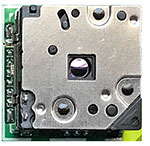 Due to its cost, thermal imaging used to be available only via pricey, dedicated equipment. This is changing, and affordable miniaturized thermal imaging modules are now becoming available. Due to its cost, thermal imaging used to be available only via pricey, dedicated equipment. This is changing, and affordable miniaturized thermal imaging modules are now becoming available.
Thermal energy detection technology is often called FLIR, which stands for "Forward Looking InfraRed" and a company aptly named FLIR is a leader in the technology. The thermal imaging modules in the AMobile G60 are sourced from FLIR's Lepton line.
What are practical applications of thermal imaging? In essence anything where heat detection provides additional clues as to status of a system or situation, or where heat detection allows serious investigation and examination in the first place.
Below are a few examples of thermal imaging applications. From left to right, a) examination of evaporator coils and compressor in a freezer, b and c) thermal footprint and functioning of heat spreader in mobile computers, and d) heat vent and heat loss areas in a residential structure.

Difference between regular and thermal imaging — Now keep in mind that there are substantial differences in infrared thermography and visible light photography. With light that is visible to the human eye, we have a very clear what is red and green and yellow and blue and all the other colors. But what about waves that we cannot see? Since those wavelengths are called infrared, should they be red?
That would make sense, but since we use thermal imaging to see different temperatures, what means hot and what means cold? How about a scale that goes from icy blue (which we identify with cold) to "red-hot" (which we identify with very hot, and then "white-hot" (which is even hotter)? 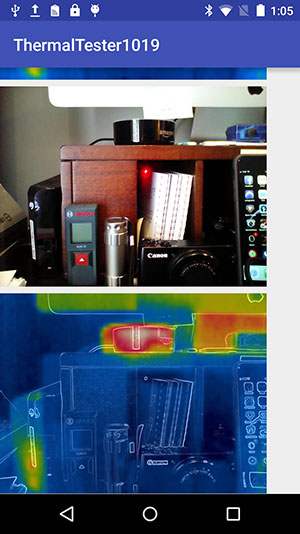 That can easily be done because the computer simply has to assign a visible color scale to the temperature scale. That can easily be done because the computer simply has to assign a visible color scale to the temperature scale.
Resolution — And there's another thing: resolution. Visible light pictures have very high resolution so that we can see all the detail. Thermal imaging uses much lower resolutions (for now anyway) because for most applications it's enough to detect where it's hot and where it's cold. Sure, more resolution is always better, but for now even low thermal resolution is usually enough to pinpoint overheating areas or areas where heat loss occurs.
What do I mean by high and low resolution? Well, a modern camera may record pictures at 12 megapixel. That makes for an image 4,000 pixels wide and 3,000 pixels tall. Currently available thermal imagers, on the other hand, may have "thermal resolution" of just 80 x 60 or perhaps 160 x 120 pixels. Thermal cameras are available with higher resolution, but even 640 x 480 is still quite costly and thus not suitable for inclusion in affordable tools such as the G60.
Merged hybrid images — Finally, given that the thermal resolution is low, isn't it difficult to figure out what you're looking at? It can be, and that's because thermal imager tools usually include a regular camera. That way you can merge the thermal image with the outlines of a regular image, making it much easier to see where it's hot and cold.
The image to the right is a screenshot of the AMobile G60. The ThermalTester app on our sample unit was still a very early version and we'll get more into that further on in the review, but the image shows the gist of it: one camera takes a regular picture, one takes a thermal picture, and then there's the merged picture. The G60 app lets you view one, two or all three.
So in this picture of my desk, you can see my big iMac27 on top (a little warm), a bit of heat emanating from its heat exchanger, then my hot-natured Alexa Echo Dot, and to the left of that my Apple Time Machine backup drive.
But wait, there's more — Having thermal imagine alone would already differentiate the G60 from your standard, average handheld. But there's more. Since the G60 was designed to be, among other things, an inspection assistant, communication is important. So there's Push-to-Talk that can communicate point-to-point or with groups. And within a range of about three miles, it can do that without needing WiFi or a data network! Since security can be an issue, the G60 also allows switching between public and private networks.
Further, there's both NFC and optional UHF-RFID, the former serving for ID verification and device security, the latter for data collection with a five-meter (17 foot) range.
As far as size and weight go, the AMobile G60 measures about 7.1 x 3.4 inches, it's about 1.2 inches thick, and it weighs about 1.2 pounds. That makes it a sizable and fairly hefty piece of equipment, but one that still fits into many pockets and pouches.
With the G60, AMobile provides an interesting product. It still looks much like a modern smartphones and since it's an Android device everyone will instantly be familiar with it. But unlike ruggedized handhelds that often don't offer much more than a consumer phone in a case, the G60 does offers a wealth of extra functionality no consumer smartphone has: Thermal imaging, Push-to-Talk, RFID, public and private network, and inherent ruggedness.
AMobile G60 technology
With the AMobile G60 specifically designed as a tough, solid handheld mobile computer specifically targeted at inspections and such, what specs and technologies did its creators employ to help the device address all these target requirements?
 Processing power is supplied by a 64-bit 1.3GHz quad-core Cortex-A53 (the successor to Cortex-A7) MediaTek MT6735 processor that's based on the ARMv8-A instruction set. It also includes an ARM Mali-T720 GPU running at 600MHz. Processing power is supplied by a 64-bit 1.3GHz quad-core Cortex-A53 (the successor to Cortex-A7) MediaTek MT6735 processor that's based on the ARMv8-A instruction set. It also includes an ARM Mali-T720 GPU running at 600MHz.
The MT6735 was introduced as a "WorldMode" smartphone platform enabling devices to seamlessly roam across high-speed 4G LTE networks uninterrupted, merging 2G, 3G and 4G technologies by supporting FDD/TDD-LTE, WCDMA, CDMA2000, TDS-CDMA, EVDO, GSM, and EDGE. It employs 28nm process technology and is used, among other devices, in various Acer Liquid Series smartphones.
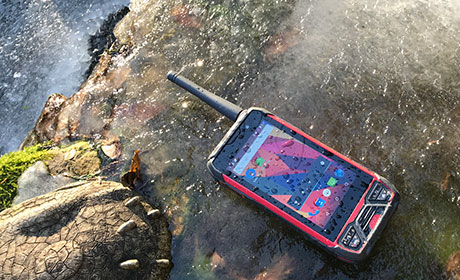 There's 2GB of LPDDR RAM and 16GB of eMMC for mass storage. While 16GB doesn't look like much at a time where Apple has long given up on 16GB iPhones, it's more than adequate if the device can use expansion cards. So for the AMobile G60 it's the 16GB, plus up to another 32GB in the user-accessible micro SDHC card slot inside the battery compartment. There's 2GB of LPDDR RAM and 16GB of eMMC for mass storage. While 16GB doesn't look like much at a time where Apple has long given up on 16GB iPhones, it's more than adequate if the device can use expansion cards. So for the AMobile G60 it's the 16GB, plus up to another 32GB in the user-accessible micro SDHC card slot inside the battery compartment.
There is a 13mp documentation autofocus camera with LED flash on the backside. Customers also get an additional 2mp vidcam in the front for video calls and conferencing.
Like most modern smartphones and tablets, the G60 comes with a bevy of sensors. That includes ambient light and proximity sensors, a 3-axis accelerometer, a 3-axis magnetic field sensor, and a barometer. Not all apps take advantage of all of these, but their presence may come in handy for custom apps.
The AMobile G60 has a user-accessible and easily removable 19.4 watt-hour Li-Ion battery. That's a full 90% more capacity than what the iPhone 8 Plus has, so battery life ought not be a problem here (AMobile estimates 8-10 hours). Charging is via desktop docking station. We'd have liked to see a separate USB port, but for security reasons AMobile decided on the proprietary pogo pins.
While the AMobile G60's 5-inch display is a bit smaller than the largest displays found on modern smartphones, it is as large or larger than most industrial handheld screens. It's certainly large enough even for mapping and GIS applications.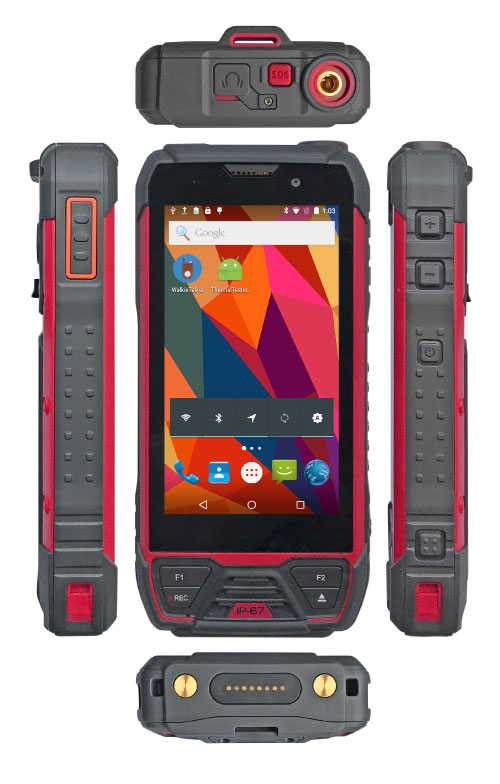
This being an Android device, it's no surprise that the AMobile G60 uses the projected capacitive ("procap") multi-touch technology pioneered in smartphones, rather than the resistive digitizer of almost all older handhelds and still used in a good number of more recent ones.
While capacitive multi-touch in industrial devices is still new (and only came after much discussion of the technology's pros and cons), it's now pretty much standard, and especially so on Android devices.
For wireless connectivity there is Bluetooth v4.1, dual-band 802.11a/b/g/n/ac WiFi, NFC, global positioning supporting GPS/GNSS/Beidou, and, of course, that "WorldMode" mobile broadband mentioned above.
The picture to the right shows the AMobile G60 from the front and from all four sides. It's an eye-catching design that merges the all-black glossy look of a modern consumer smartphone with all-business protective rubber-cladding, meticulous sealing, and space for the big battery and industrial grade features and expansion.
Going around the AMobile G60 you find a small number of physical controls but not much in terms of ports. This is a sealed device, and that means the fewer openings that must be protected against immersion the better.
The left side has a dedicated Push-To-Talk key. On the right side are the unit's power button, volume up and down keys, and a dedicated camera button. On top is the 3.5mm audio jack with a tight sealing plug, a red "SOS" button, and next to it the unit's PTT antenna.
The front of the AMobile G60 is dominated by the large display whose surface glass extends well beyond the perimeter of the LCD, a characteristic common to virtually all capacitive touch devices, so that fingers do not bump into a border during touch.
Beneath the display are two programmable function keys, as well as dedicated Record and Upload keys. Three standard Android controls (Back, Home, Open Apps) implemented here in software, onscreen. We'd actually have preferred those keys as dedicated capacitive touch areas.
AMobile G60: design and construction
Industrial handhelds like the AMobile G60 are very much tools for the job. They may have, of course, full phone functionality, but that's just an extra. The primary purpose is getting work done, and provide that capability and functionality in a package that makes sense for working professionals who don't have the time nor inclination to baby their handheld out there on the job. With that, let's take a look at how the G60 is made.
The pictures below show the backside of the AMobile G60, what it looks from the outside (left), an then with the battery compartment cover off (right). The red housing with dark-gray inserts certainly makes the G60 hard to miss, which is good for a tool. It's form follows function here. Screws are in plain sight, which adds a nice mechanical touch to the design and also makes it so much easier to open the housing should the need ever arise.
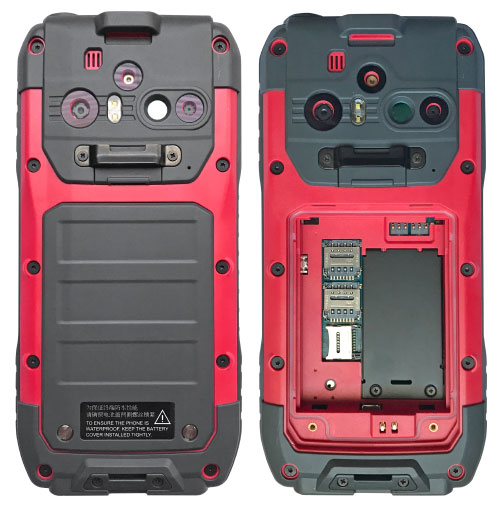
The red polycarbonate housing has fused dark-gray rubber overmoldings that make the device grippier and easier to hold, and they also provide extra protection.
The G60's battery is replaceable and externally accessible. The polycarbonate battery compartment cover has a replaceable silicon seal in a tongue-and-groove design. We like the fact that the seal is replaceable, but its square cross section and little tabs that need to fit into cutouts along the groove present the danger of kinking or improper fit.
The battery compartment cover is held in place with two flat blade screws that stay in place and cannot fall out. Electrical contacts assure that the device won't come on unless the compartment is properly in place and secured. The battery is a 3.8 Volt, 5,100 mAH Lithium-Ion design that provides 19.4 watt-hours. The spec sheet suggests run times of 8 to 10 hours between charges, which should be good for a full shift.
Inside the battery compartment, beneath the battery, are cutouts for access to the G60's dual micro-SIM slots as well as the unit's microSD card slot. Of the two SIM slots, one is described in the manual as for a "4G private network," the other one "2G/3G/4G" going through the main processor. The microSD card is of the SDHC variety, can handle cards up to 32GB, and is also SDIO 3.0 compatible (which means it covers I/O functions for cards other than storage).
The bottom of the battery compartment also shows a removable black metal cover held in place with two screws. Underneath sits something one doesn't see often in handhelds: a mini PCIe card socket. That one is likely meant to be used with a mobile broadband card.
In terms of overall construction, the AMobile G60 has a very strong magnesium frame attached to the front part of its polycarbonate housing, with the display mounted on one side of the frame and the main and subsidiary boards mounted on the other.
The two halves are secured together via ten Torx head screws. Once those are undone, the two halves separate easily, with no wires that could break or come loose between them. Instead, AMobile is using surface mount pressure contact (LED flash, buttons, and antennae are examples).
Sealing between the two halves of the G60 housing is via a replaceable silicon seal that sits in a groove around the perimeter of the front part of the housing, and presses against the back part. The silicon seal, which has a square cross section, loosely sits in its groove and tiny tabs on the seal must align and fit into corresponding cutouts along the groove. Upon reassembly, make certain the seal sits properly in its groove and isn't twisted or kinked in places, as that would compromise protection. We'd like for both this seal and the one in the battery compartment to be more solid and not as easily twisted or dislodged.
The image below shows what it looks like inside the AMobile G60:
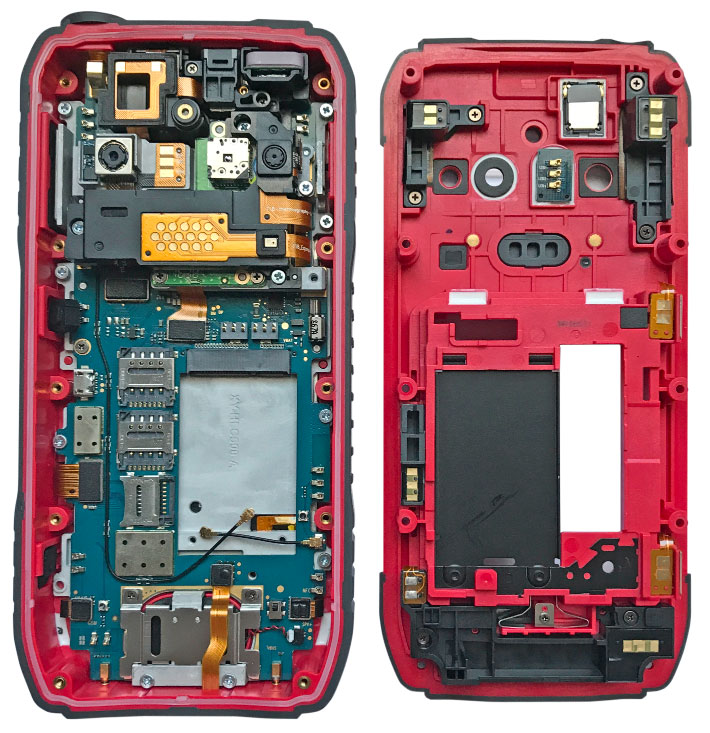
Overall, the main board inside looks more like a miniaturized PC motherboard than what we usually find inside handhelds. The top third of the board is covered with a number of onboard peripherals such as the speaker, antennae, contacts for an expansion module, the infrared camera components, as well as the main documentation camera with its LED flash. Everything is mounted on an elaborate, sturdy magnesium chassis.
With the exception of a couple of separate antenna wires for an optional mPCIE module and small speaker wires, everything is communicating via miniature flat ribbon cables and pressure connectors.
The image compilation below shows some of the details of the AMobile G60. On the left you can see a closer-up of groove and pressure sealing method with the silicon seal sitting in the groove. Note the little tab that needs to fit in the cutout. On the right the mPCIe slot. Not a common sight in handhelds.

Below a close-up of camera central, the area inside the G60 where all of the away-facing cameras and imaging-related components sit. On the left the unit's main documentation camera, next to that the dual LED flash/illuminator. Next to that what is likely the thermal infrared camera, and then a secondary camera that goes with the thermography system. Impressive.

Like the other ARBOR mobile computers we've had in our lab, the AMobile G60 is a remarkably clean and well organized design. Particularly impressive is the elegant, functional magnesium frame with its custom-designed main and subsidiary boards that together form a compact, logical, and very clean solution.
Contemporary display — 5-inch and procap multi-touch
The AMobile G60's 5-inch display would have looked huge in a handheld computer or smartphone just a few years ago. Today it looks just about right — not too large but also not too small to work on. The AMobile display is crisp and sharp. Its 1280 x 720 pixel resolution is not quite as high as the full 1920 x 1080 pixel 1080p screen of the 5.5-inch iPhone 6/7/8 Plus, but 294 pixels per inch is still super-sharp and actually beats all of Apple's retina iPads and MacBooks save the iPad mini Retina (324 pp). It's much sharper than the original iPhone (163 dpi), and even the 5K Retina iMac27 this review was written on (218 dpi). And it's an IPS (In-Plane Switching) screen, which means it has perfect viewing angles from all directions, without any color or contrast changes.
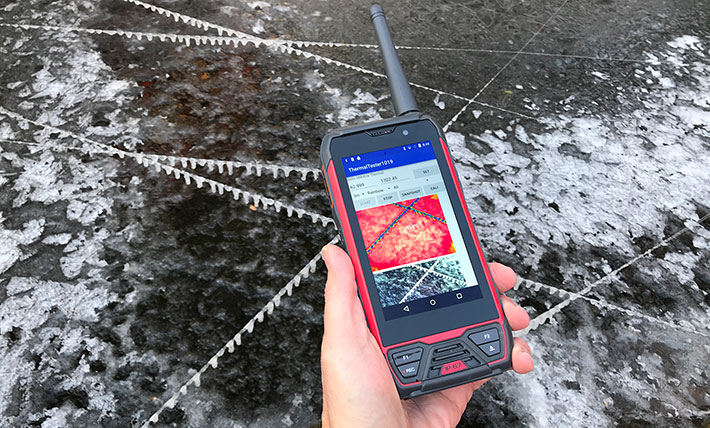
Capacitive multi-touch works as everyone expects from a handheld these days — quickly and effortlessly. The touch controller AMobile uses in the G60 is more sensitive than that in most earlier capacitive touch devices. That means it can work when wearing certain types of thin gloves. The device doesn't come with a stylus and the company doesn't offer an optional capacitive pen. Any 3rd party capacitive pen will work, though those generic pens with their broad tips don't offer much more accuracy than the tip of a finger. It's not that important anyway as Android was specifically developed for capacitive multi-touch with a finger.
Android 5.1
The AMobile G60 runs Android 5.1 "Lollipop." According to the Android Developers page, as of July 11, 2016, Lollipop still had a 25% marketshare among all Android versions in January 2018 (see latest figures), with each of the three most recent Android versions (i.e. 5.x, 6.x, and 7.x) having roughly 25%. As is, Android version 5.x introduced enterprise-strength security to Android, moving the platform a big step forward. It's quite possible that the G60 will get an upgrade to Android 7.x.
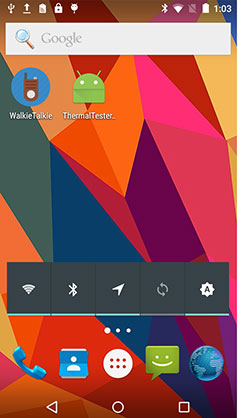  Given Android's massive market share in handhelds, Android-based work devices have instant appeal and familiarity to those who already use Android smartphones and/or tablets at home or at work. Though often customized by voice and data service providers, the basic workings of the Android interface are very widely known by now, and a very large number of apps are available for download. Android software development and expertise is commonly available, and making Android devices available on the job can save training as well as deployment costs. Given Android's massive market share in handhelds, Android-based work devices have instant appeal and familiarity to those who already use Android smartphones and/or tablets at home or at work. Though often customized by voice and data service providers, the basic workings of the Android interface are very widely known by now, and a very large number of apps are available for download. Android software development and expertise is commonly available, and making Android devices available on the job can save training as well as deployment costs.
Undeniably, the total number of available apps for a handheld software platform has become a crucially important marketing issue, as is how easily users can download apps. Apple has its slick and massive App Store. Android offers the official Google Play store, as well as third party alternates such as the Amazon Appstore for Android, Slide ME, and several others.
There is, however, an important difference between consumer and industrial markets here. Whereas a vast number of easily accessible apps is a big plus for consumers, many industrial and enterprise deployers do not want their workforce download (and distracted by) apps into devices used for work. What are the answers to this potential problem?
One approach is to use Android AOSP, which stands for Android Open Source Project, and is an open-source software stack and project, led by Google itself, but without the ability to use the Google Play store and some of the major Google apps. Android AOSP, however, still has access to alternate app stores.
Another possibility is using something like 42Gears.com's SureLock. SureLock replaces the Android desktop and allows control of applications that are available to users. It can even be configured to run in "kiosk mode" with just a single application that is always active. This way, systems integrators or IT personnel can configure units for specific use and applications, eliminating the temptation that comes with a full load of consumer apps.
Our AMobile G60 review sample unit came with only a basic selection of apps and none of the Google-branded apps such as Maps, Gmail, Drive, etc.. It also did not have the Google Play store.
Very good cameras
Like virtually every handheld these days, the AMobile G60 has both a front and a rear camera. The front one is primarily for video calls and conferencing, and offers 2 megapixel resolution. The more powerful one in the rear is for documentation and general photography and uses a 13 megapixel imager. Camera settings allow selecting from four resolutions: 1, 4, 6 and 9.5mp. The test pictures we took at the highest setting came out in 4,096 x 2,304 pixel resolution, which is 9.5 megapixel. Both cameras can be used for stills as well as for video.
Cameras integrated into rugged vertical market handhelds and tablets have been underwhelming in the past (to say the least), with even the best ones lagging behind what's available in dedicated point & shoots and consumer smartphones. 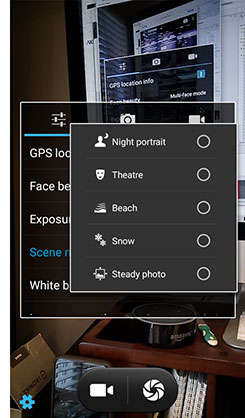 This is changing now, most likely driven by the demand of customers used to the excellent cameras built into consumer smartphones. And indeed, the rear-facing documentation camera of the AMobile G60 is very good. Not by DSLR standards, of course, but definitely more than up to the job of documentation whatever needs to be documented out there in the field. The test pictures we took with the device were very sharp and devoid of the frustrating over-compression of almost all older integrated cameras. And the camera was quick and nimble.
This is changing now, most likely driven by the demand of customers used to the excellent cameras built into consumer smartphones. And indeed, the rear-facing documentation camera of the AMobile G60 is very good. Not by DSLR standards, of course, but definitely more than up to the job of documentation whatever needs to be documented out there in the field. The test pictures we took with the device were very sharp and devoid of the frustrating over-compression of almost all older integrated cameras. And the camera was quick and nimble.
The screen snap to the right shows some of the camera settings screens, and what it looks like in picture-taking mode.
The user interface is quite elaborate, with 14 scene settings, 8 white balance settings, +/-3EV exposure control, face detection (including multi-face, smile-shot, etc.), anti-shake, 2/10 second self timer, 40 or 99 continuous shots, ISO settings from 100 to 1600 and auto, and more. Users can also set sharpness, hue, saturation, brightness and contrast to low, medium or high. Speed demons will like the zero shutter delay setting. The camera can shoot in HDR, multi-view, panorama, motion tracking, live photo, and picture-in-picture mode. We've come a very long way here.
Users can edit pictures right on the AMobile G60. There is a wealth of functions available, including 10 color effects, numerous frames, cropping, straightening, mirroring, numerous filters, and even such advanced operations as sharpening, hue, vibrance and curves. The camera app can also send images to Messaging, email, Skype, OneDrive or whatever other social media apps you have on the device. And images can also be converted to PDF.
In video mode, there is a special meeting recording setting for audio recording, and the microphone can be turned on and off. There is also time lapse video with a picture taken shot every one to 10 seconds, and users can set video quality to low, medium, high and fine. Noise reduction is available as well.
Having all those many settings and features available will be important to some users, but what's most impressive about the AMobile camera apart is its speed and quality. It is well suitable to document jobs both in stills and in video.
The pictures below were shot with the AMobile G60 in 9.5mp mode. Click on the image to bring up a full-size version.
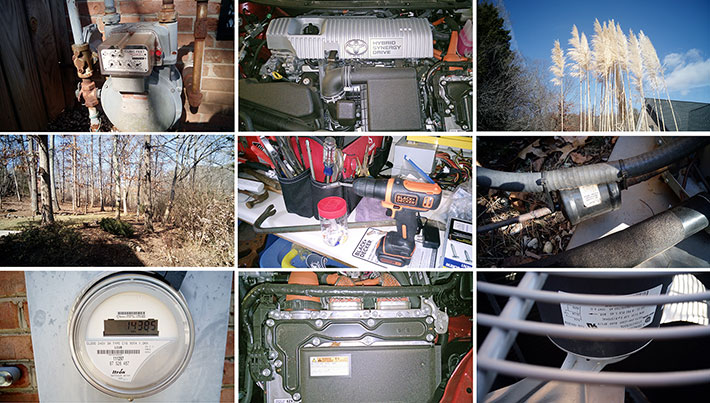
The AMobile G60 camera is capable of taking much better pictures than we generally see from industrial handhelds. There is very good sharpness and image detail, and little of the massive compression that often renders pictures from such integrated cameras useless.
Video is also much better than what we've come to expect from cameras integrated into rugged devices. Frame rate and focusing are quick and the camera doesn't fall behind. The maximum 1920 x 1080 pixel 1080p recording format is very useful. We wish, though, that recording size could be selected directly, rather than via the "low, medium, high and fine" quality options.
Note that the camera applications that come with mobile operating systems are often replaced with third party applications optimized for certain tasks, or developers and systems integrators include camera and video functionality directly into custom applications.
In summary, the still image and video functions of the AMobile G60 are plenty good enough for virtually any documentation jobs.
And just to reiterate, the inclusion of thermal imaging into the G60 makes it pretty much unique among rugged handheld computers. Below, one more time, from left to right: the app interface, the low-res (80 x 60 thermal image, the much higher res regular image, and then the hybrid.
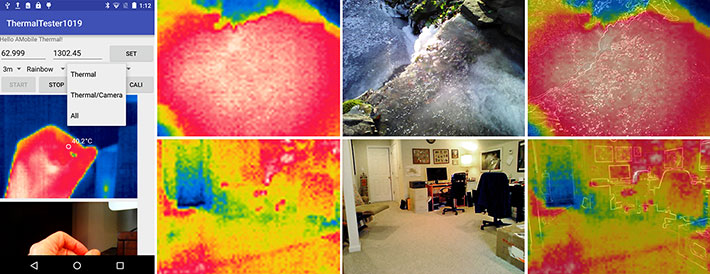
Seriously tough and rugged
Take one look at the G60 and you won't doubt its inherent ruggedness. This is a substantial, solid handheld computer that's clearly built as a tool for the job. And its ruggedness specs are impressive.
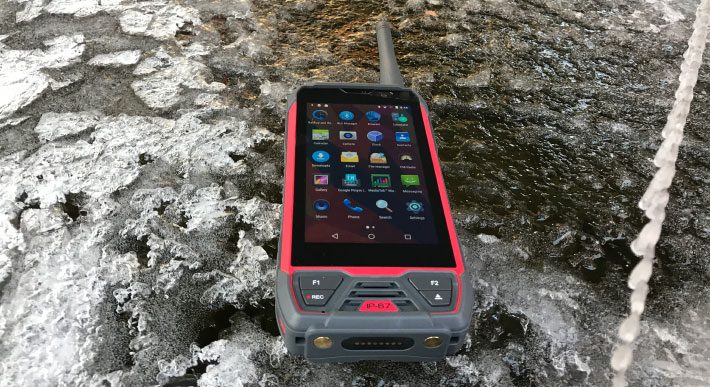
To fend off the elements, the AMobile G60 carries IP67 sealing where the "6" means it's completely dustproof, and the "7" that it is also sealed against, according to the IP classification system chart, the effects of immersion into water down to about a meter, something which the company proudly demonstrates at industry trade shows. That means the G60 can easily survive not only rain or a good hosing down, but also a drop into a puddle or even a stream.
No one, of course, will intentionally drop a valuable tool for the job into water, but it can happen, and then it's better to have an IP67-sealed device than one that only goes to IP65, like a good number of rugged handhelds on the market. That's because IP65, while plenty good enough for many applications, still carries the caveat "limited ingress permitted." When it comes to electronics, that's really not what you want.
The device can also handle drops from five feet. Consumer smartphones may survive a four foot drop inside a third party case, and even then there are no guarantees that they can survive a drop, let alone multiple drops. Five feet is more than dropping a device while using it with your hands while walking (about four feet), so there's an extra reserve.
The stated operating temperature range of 5 to 131 degrees Fahrenheit (-15 to 55 degrees Celsius) is wide enough to allow the device to be used virtually anywhere. The G60 had no problems whatsoever handling our outdoor testing on an icy-cold morning at 10 degrees Fahrenheit.
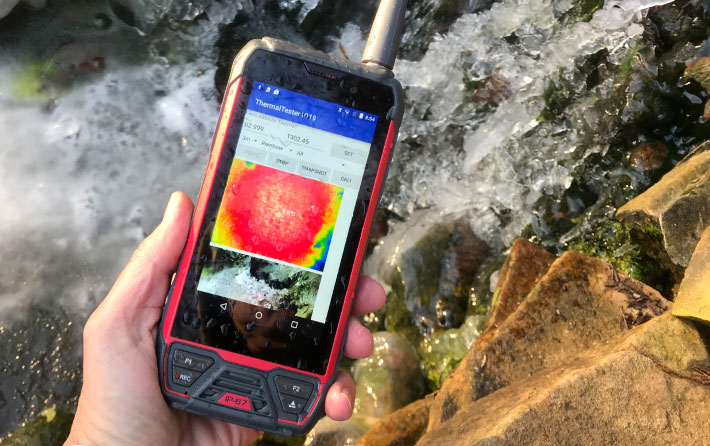
The impressive strength provided by the G60's internal magnesium frame suggests a high degree of toughness and ability to withstand accidents and abuse. And the device does feel absolutely rock-solid. External ports all have tight-fitting protective rubber plugs with their own replaceable o-ring seals.
However, while AMobile's literature mentions MIL-STD-810G certification, it does not say which MIL-STD-810G or similar tests, specifically, have been performed. Vibration, for example, can be a big issue if a device rattles around in a vehicle or if it's mounted on something that vibrates a lot. Users may also want to know its ability to handle tumbles, altitude, shock, shielding, and perhaps salt fog resistance and so on. We'd encourage ARBOR to make the results of such tests available in its sales literature.
That said, we're confident that the AMobile G60 will hold up very well in the field and under tough conditions. Its structure and design are exceptional, its sealing is well thought-out, and we didn't hesitate to dunk the device in our testing. But we'd still like to see more official test results.
Summary: AMobile G60 — tough and rugged Android mobile computer for worldwide deployment
AMobile's G60 "Mobile Inspection Assistant" is quite unique. Yes, it's a rugged Android handheld computer and phone, but it's also so much more. The big stubby antenna indicates that this tool for tough jobs has push-to-talk functionality without the need for a public data network. And then there's integrated thermal imaging.
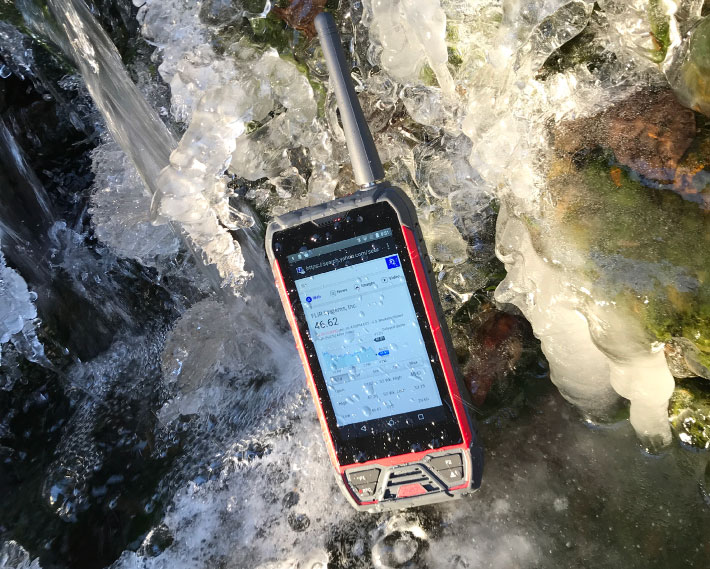
IP67 sealing means the G60 is totally dustproof and can even handle total immersion in water. It can survive 5-foot drops thanks to its tough internal magnesium frame and substantial external protection. Despite its solid build, the G60 remains fairly compact, pocketable, and even suitable for one-handed operation. 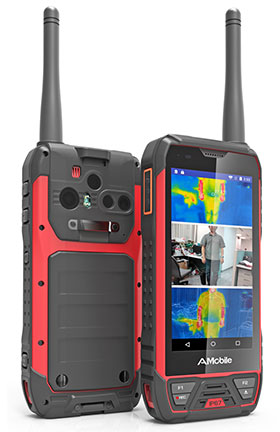
Sporting a spacious large, bright, and very sharp (294 dpi) 5.0-inch capacitive multi-touch display means the AMobile G60 has enough screen real estate for complex applications, and enough sharpness for even minute details. The large replaceable battery should last well beyond a full shift and more.
Built around the MediaTek "WorldMode" MT6735 smartphone platform, the dual-SIM AMobile G60 merges 2G, 3G and 4G communication technologies and is capable of seamlessly roaming across high-speed 4G LTE networks uninterrupted.
An internal mPCIe expansion slot means there can be both public and private mobile broadband communication.
The AMobile G60's integrated FLIR-based thermal imaging allows all sorts of inspection work where detection of heat signatures is required for the job. Merging those heat signatures with conventional photography makes for easy interpretation.
There are also an excellent 13-megapixel documentation camera and a 2-megapixel frontal camera for video conferencing. And the unit features NFC, dual-band 802.11ac WiFi, GPS and Bluetooth 4.1. Optional via expansion modules include a high speed or long range barcode reader, UHF reader, and a laser distance reader
With the Android-powered G60 Mobile Inspection Assistant, AMobile provides a rugged, rock-solid and quite unique Android handheld computer that can do much more than most. -- Conrad H. Blickenstorfer, January 2018
AMobile G60 Specs:
| Added/changed |
Added 01/2018
|
| Type |
Rugged Android handheld (Mobile Inspection Assistant)
|
| Processor |
1.30GHz 64-bit Octa-core MT6753T ARM Cortex-A53
|
| Graphics |
ARM Mali-T720 GPU running at 600MHz
|
| OS |
Android 5.1
|
| Standard/Max RAM |
2GB LPDDR2 |
| Disk/drive |
16GB eMMC onboard, plus microSD card storage (SDIO 3.0 support, up to 32GB) |
| Display type |
TFT, 500 nits |
| Display size/resolution |
5.0-inch, 1280 x 720 pixel, 294 ppi (pixels per inch) |
| Digitizer |
5-point projected capacitive multi-touch, glove-capable |
| Keyboard/keys |
2 customizable keys, power, record, volume, camera shutter, push-to-talk, SOS
|
| Navigation |
Touch
|
| Expansion slots |
1 x microSDHC Card, 2 x micro-SIM card (one 4G private network, one 2G/3G/4G), 1 x mPCIe
|
| Housing |
PC+ABS polymer over magnesium frame
|
| Size |
3.43 x 7.05 x 1.2 inches (87 x 179 x 30 mm)
|
| Weight |
1.17 lbs (530 grams) with battery
|
| Operating temperature |
Est: 5° to 131°F (-15° to 55°C) |
| Ingress protection |
IP67 (totally dustproof, sealed against full immersion to 3.3 feet) |
| Humidity |
5-95% non-condensing |
| Drop |
5-foot drops |
| Vibration |
MIL-STD-810G testing |
| Altitude |
Unknown |
| Tumble |
Unknown |
| ESD |
Unknown |
| Power |
3.8V, 5,100mAh 19.4 watt-hour ("8-10 hours") |
| Camera |
Front: 2.0mp, rear: AF 13mp with LED; FLIR Lepton thermal imaging camera |
| GPS |
A-GPS (GPS/Beidou/GLONASS) |
| Data collection |
Optional via expansion modules: High speed or long range barcode reader, UHF reader, laser distance reader
|
| Sensors |
Ambient light, proximity, 3-axis accelerometer, 3-axis magnetic field, barometer |
| Communication |
Dual-band 802.11a/b/g/n/ac, Bluetooth 4.1 + HS BLE, NFC, 2G GSM/GPRS/EDGE, 3G WCDMA/CDMA2000, 4G FDD+TDD, 4G DRX, GPS/GNSS/Beidou |
| Interface |
Dock: 1 x 8-pin connector with USB 2.0 port high speed / OTG; optional RS232/RS485/USB and RJ45 via adapter snap-on. |
| Price |
Starting at US$??? |
| Spec sheet |
 AMobile G60 spec sheet (PDF) AMobile G60 spec sheet (PDF)
|
| Web page |
AMobile G60 web page |
| Contact |
AMobile Intelligent
10F., No.700, Zhongzheng Rd.
Zhonghe Dist., New Taipei City 235
Taiwan, R.O.C.
Tel: 886 2 8226 9396
Fax: 886 2 8226 9398 |
|



